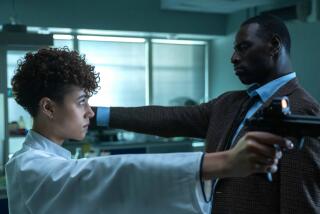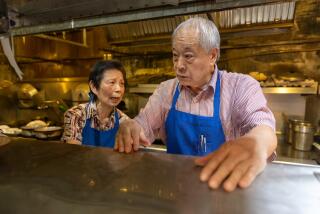ANNA MAY WONG AND THE DRAGON-LADY SYNDROME
- Share via
She was the first Asian-American film star when pictures learned to move but not talk. And on the Walk of Fame near Hollywood and Vine there’s a star in her honor.
Anna May Wong was the Oriental beauty of her day, with doleful, mesmerizing eyes and fashionable bangs to the eyebrows. The Roaring ‘20s image of a China doll.
Today, long after her image has faded from memory, Asian-American film makers are focusing on her life again. Film festivals at UCLA and in New York recently held tributes for her.
Wong’s career offers interesting parallels between then and now. For one thing, the dilemma she faced then still confronts Asian-American actors now: either play the Oriental stereotypes that Hollywood wants you to play--or don’t play at all.
Because she played over and over again the exotic slave girl, the villainous Dragon Lady, the mysterious siren of the Orient with deadly charms, it’s not surprising that in her obituary (she died of a heart attack in 1961) Time magazine dubbed her “the screen’s foremost Oriental villainess.”
What was true of Hollywood six decades ago is true today. Hollywood still delights in spewing out superficial characters and trite stories: Oriental damsels in distress, Vietnamese adversaries battling Chuck Norris, Rambo, et al., Chinatown gangsters waging war, Asian bad guys in general menacing the meek and hapless who need the help of MacGyver, Magnum and other all-American heroes.
While authentic dramas on the struggles of newly arrived immigrants deserve to be told, Hollywood tends to look past the truth of such events and zoom in on the exploitative elements.
Born Wong Liu Tsong, the actress had her first major success in 1924 when she played a Mongol slave in the classic film “The Thief of Bagdad” with Douglas Fairbanks. She was a striking vision opposite one of the biggest stars of silent films, and she wasn’t overshadowed.
But as early as 1928 Wong was disgusted with the way Hollywood treated her. So she took a big chance and went to Europe. In Britain and on the Continent she was a smash, starring in English, French and German films and stage productions, in which she fluently did all the dialogue.
In a 1933 magazine interview, she explained her move: “I was so tired of the parts I had to play. Why is it that the screen Chinese is nearly always the villain of the piece, and so cruel a villain--murderous, treacherous, a snake in the grass. We are not like that.
“How should we be, with a civilization that’s so many times older than that of the West. We have our own virtues. We have our rigid code of behavior, of honor. Why do they never show these on the screen? Why should we always scheme, rob, kill? I got so weary of it all--of the scenarist’s concept of Chinese characters. You remember ‘Fu Manchu’? ‘Daughter of the Dragon’? So wicked.”
Like Josephine Baker, Wong probably could have stayed abroad indefinitely as a major headliner. However, she was homesick for Los Angeles and her family and decided to return.
Back in Hollywood, no surprise, her first movie was another crime melodrama, “Daughter of the Dragon” (1931), in which the sinister Fu Manchu dies and his daughter (Wong, naturally) carries on the notorious way of life.
Nothing had changed. Her films in the 1930s were mostly grade B melodramas in which she often looked sleek and mysterious in her standard costume: the cheongsam.
Perhaps the worst insult to Wong was when MGM cast Luise Rainer as O-lan in “The Good Earth” and made her up to look “Chinese,” denying Anna May the lead role in an A movie, a common occurrence.
In another interview, Wong told her side. MGM had asked her to take a test for the role of the concubine Lotus. Said Anna May to the studio: “I’ll be glad to take the test, but I won’t play the part. If you let me play O-lan, I’ll be very glad. But you’re asking me--with Chinese blood--to do the only unsympathetic role in the picture, featuring an all-American cast portraying Chinese characters.”
After the test was completed, the studio wanted her for Lotus, Wong said, but she refused.
Instead, she traveled back to her roots. She visited China for the first time in 1936, but the reception was not what she had hoped for.
Reporters criticized her portrayals of Chinese women, saying the roles were derogatory. Why, they asked, did she do films like that?
It’s the same question posed to some Asian-American actors today. But what was Wong’s response? She didn’t write the characters, she said; she only obeyed the directors’ instructions. Besides, those were the only roles available to her.
Wong confessed that her knowledge of China came from writers like Pearl Buck. China, to her, was a place where the people always sipped tea and philosophized about life. She knew little about being Chinese. After all, she was born in L.A., a third-generation American. Her father was born in Sacramento. His father had emigrated to California during the Gold Rush.
Wong stayed in China for a year, soaking up the culture, the people, the way of life. Yet when she returned to Los Angeles, she said: “I am convinced that I could never play in the Chinese theater. I have no feeling for it. It’s a pretty sad situation to be rejected by the Chinese because I’m too American.”
Equally sad was the fact that Hollywood didn’t see her as an American. She was nearly always the foreigner, the outsider who didn’t belong in the mainstream of society and was cast as such. This was, after all, the era of the “yellow peril,” when America was having bad dreams about the growing force of the Asian peoples.
Today, Hollywood still sees Asian-Americans as foreigners, so it’s rare that one sees them in meaningful stories as active-in-society Americans. One might cite Pat Morita in TV’s “Ohara,” but even he is saddled with ethnic baggage, mouthing quaint aphorisms and meditating in Hollywood’s hackneyed conception of Oriental mellowness.
So what was it like 50 years ago when Wong returned from China?
A 1937 newspaper article, which could have been written in 1987 with movie titles changed, radiated optimism for Chinese actors, pointing out that the Sino-Japanese War meant more movies would focus on that conflict, “a new era for China’s players in Hollywood.”
Twentieth Century Fox was continuing to churn out its “Charlie Chan” and “Mr. Moto” series. RKO was planning “North of Shanghai,” the paper said, offering more opportunities for Oriental actors. It also reminded readers of Goldwyn’s “The Adventures of Marco Polo,” which gave work to some 600 Chinese-American actors in palace and battle scenes, MGM’s “The Good Earth” and Columbia’s “Lost Horizon.”
At Paramount, Wong had a new contract and a new movie, the starring role in a grade B thriller, “Daughter of Shanghai.” This time she played a sympathetic character in a plot line that echoes to the present: She exposes an underworld racket in which large numbers of illegal aliens are smuggled into the United States.
In 1942 Wong, only 37, retired. She never married. One of her last films in a movie comeback in 1960 was “Portrait in Black.” She played Lana Turner’s maid.
Asian-American film makers are proud of Anna May Wong because she achieved a remarkable measure of stardom in spite of Hollywood’s tunnel vision, a tribute to her tenacity and talent. Her recognition is especially appropriate now, since the mood of America seems so much like that in Wong’s days.
More to Read
Only good movies
Get the Indie Focus newsletter, Mark Olsen's weekly guide to the world of cinema.
You may occasionally receive promotional content from the Los Angeles Times.







